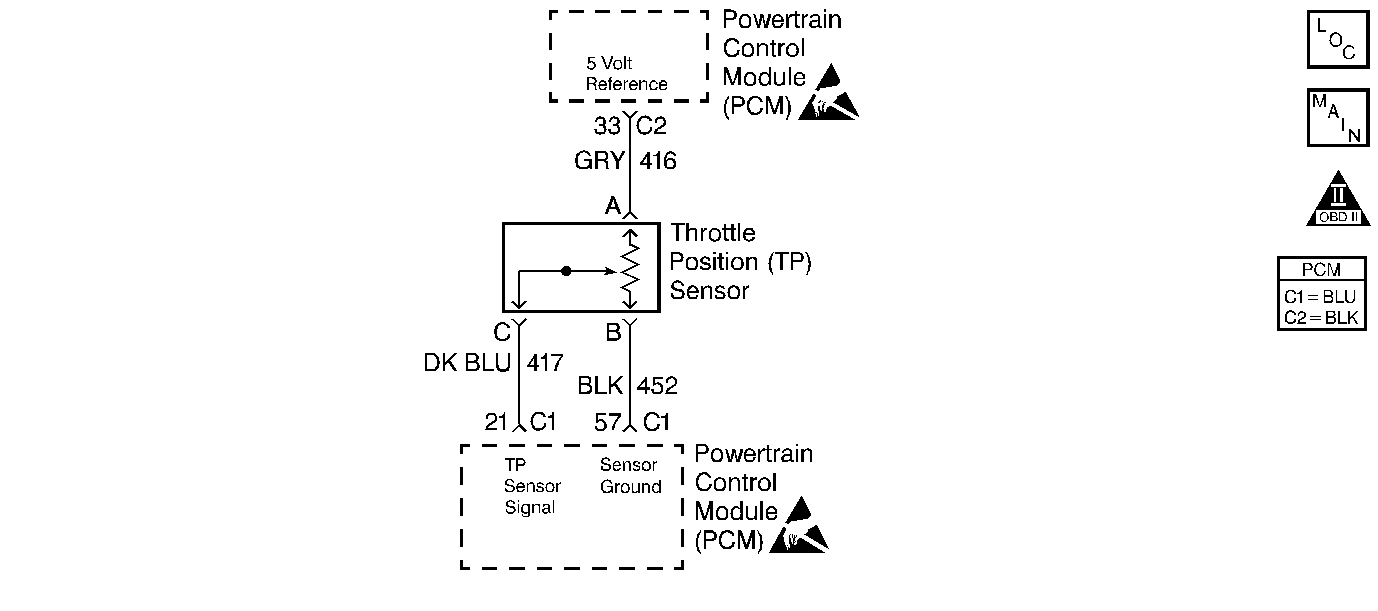
Circuit Description
The powertrain control module (PCM) supplies a 5.0 volt reference signal and a ground to the sensor. The throttle position (TP) sensor sends a voltage signal back to the PCM relative to the throttle plate opening. The voltage will vary from approximately 0.35 volts at closed throttle, to over 4.65 volts at wide open throttle.
Conditions For Running The DTC
The engine is running.
Conditions for Setting the DTC
The TP sensor reads less than 0.20 volts for 6.25 seconds.
Action Taken When the DTC Sets
| • | The control module illuminates the malfunction indicator lamp (MIL) if a failure is detected during 2 consecutive key cycles. |
| • | The control module sets the DTC and records the operating conditions at the time the diagnostic failed. The failure information is stored in the scan tools Freeze Frame and Failure Records. |
Conditions for Clearing the MIL/DTC
| • | The control module turns OFF the MIL after 3 consecutive drive trips when the test has Run and Passed |
| • | A history DTC will clear if no fault conditions have been detected for 40 warm-up cycles. A warm up cycle occurs when the coolant temperature has risen 22°C (40°F) from the startup coolant temperature and the engine coolant reaches a temperature that is more than 70°C (158°F) during the same ignition cycle. |
| • | Use a scan tool to clear the DTCs. |
Diagnostic Aids
Whenever this DTC cannot be duplicated, use the information included in the Freeze Frame data in order to evaluate the conditions when the DTC set.
A faulty A/C sensor could set a DTC P0122. Disconnect the A/C electrical connector. If the TP reading returns to normal, replace the A/C refrigerant sensor.
An intermittent may be caused by any of the following conditions:
| • | A poor connection |
| • | Rubbed through wire insulation |
| • | A broken wire inside the insulation |
Thoroughly inspect any circuitry that is suspected of causing the intermittent complaint. Refer to Testing for Intermittent Conditions and Poor Connections in Wiring Systems.
If a repair is necessary, refer to Wiring Repairs or Connector Repairs in Wiring Systems.
Test Description
The numbers below refer to the step numbers on the diagnostic table:
-
The TP sensor has an auto zeroing feature. If the voltage reading is between 0.20-0.90 volts, the PCM will automatically assume that this is a closed throttle position (0 percent).
-
This simulates a DTC P0123. If the PCM recognizes the high voltage signal, this indicates that the PCM and the wiring are OK.
-
Important: The powertrain control module (PCM) uses a single internal 5.0 volt power supply to supply power to all the engine control components. If one component shorts its 5.0 volt reference circuit to ground or battery voltage, the other 5.0 volt reference circuits will also have a low or high voltage.
If any additional DTCs are set, test the 5.0 volt reference circuits for a short to ground.
-
The replacement PCM must be programmed and the Crankshaft Position System Variation Learn procedure must be performed.
Step | Action | Values | Yes | No | ||||
|---|---|---|---|---|---|---|---|---|
1 | Did you perform the Powertrain On-Board Diagnostic (OBD) System Check? | -- | ||||||
Does the TP sensor voltage read below the specified value? | 0.2 V | |||||||
3 |
Does the TP sensor voltage read below the specified value? | 0.2 V | ||||||
Does the TP sensor voltage read more than the specified value? | 4.0 V | |||||||
5 |
Does the TP sensor voltage read more than the specified value? | 4.0 V | ||||||
|
Important:: The powertrain control module (PCM) uses a single internal 5.0 volt power supply to supply power to all the engine control components. If one component shorts its 5.0 volt reference circuit to ground or battery voltage, the other 5.0 volt reference circuits will also have a low or high voltage.
Did you find and correct the condition? | -- | |||||||
7 |
Did you find and correct the condition? | -- | ||||||
8 |
Did you find and correct the condition? | -- | ||||||
9 |
Did you find and correct the condition? | -- | ||||||
10 |
Did you find and correct the condition? | -- | ||||||
11 | Replace the TP sensor. Refer to Throttle Position Sensor Replacement Did you complete the replacement? | -- | -- | |||||
|
Important:: The replacement PCM must be programmed. Replace the PCM. Refer to Powertrain Control Module Replacement/Programming . Did you complete the replacement? | -- | -- | ||||||
13 |
Does the DTC reset? | -- | System OK |
